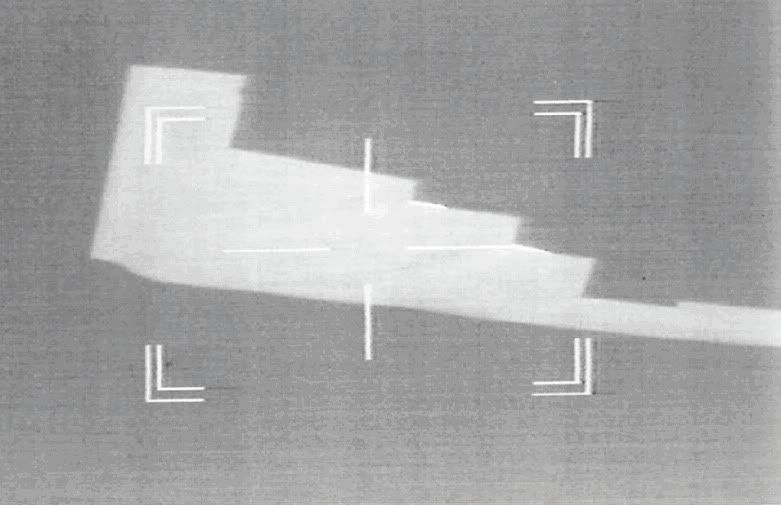Shroom Man 777 wrote:It says FLIR, not IRST. Though I have no idea what's the difference between the two. What IS the difference between FLIR and IRST?
There are three basic categories of infra-red system. They are:
FLIR. This stands for Forward Looking Infra Red. Essentially this is just a camera that points forward and produces a picture in the cockpit that shows the field of view as an expression of heat differentials in that view. These have been in use for a surprisingly long time. German nightfighters in WW2 had a very simple, elementary system called "Spanner" that worked much along these lines. It was used to detect the hot exhausts on night-flying bombers. Some versions of Spanner used an infra-red searchlight to illuminate the target. Neither worked very well. At the same time, allied ASW aircraft were experimenting with very elementary forward-looking infra-red to detect submarines. In that case, the introduction of the snort caused serious problems in detecting subs. Radar was reduced to minimal value (now it had to pick up a snort head rather than a whole sub). That change reduced ASW aircraft search ability for swaths of sea hundreds of miles across to much lower levels. The idea of using IR was that the exhaust gases from a snorting sub were very hot and could be detected at range. This idea worked very well and is still used today - until quite recently, ASW aircraft were the major users of FLIRs. The introduction of FLIRs also led to a scientific revolution is oceanography since it revealed that the sea was not uniform in termperature. Up to that point it had been assumed that the sea was largely uniform with temperature differences being a gross characteristic only. ASW aircraft returning from flights using their new FLIRs reported that the sea was actually an amazingly complex pattern of different termperature bands and zones.
More recently FLIRs have been used for ground attack missions. They negate the effectiveness of some types of camoflage and make targets like tanks (with warm engines) and people (hearts still beating - matter to be soon rectified) stand out clearly. They allowed the aircraft to distinguise between buildings that were occupied and those that were not. All sorts of goodies like that. With the development of laser-guided bombs, it wasn't long before FLIRs were hooked to laser designators so the designator could be placed on the right target. These were usually two-pod systems with the FLIR carried on one pylon and the designator carried on the other. These had a lot of disadvantages because the target would pass out of the field of view of the FLIR and be lost. That would break the laser lock and the bomb would go astray. The answer was to stabilize the FLIR and allow the pilot to lock it and the laser onto a specific target. That would allow him to maneuver within limitations without losing the target. That's an IRTS. There are loads of these systems now, everybody and his brother offers one. The Turks offer ASELPOD, the French Atlis, the US Lightening, Lantirn and Sniper, the British TIALD (although the British replaced it with Lightening for reasons they are reluctant to elaborate on. The Saudis replaced their TIALDs with Sniper). Lots of others. They are available as one-pod and two-pod systems although the two-pod is usually preferred. They can also be mounted internally.
IRST. This stands for Infra Red Search and Track. It's quite a different animal from the FLIR. What this system does is scan an area in front of the platform aircraft for an infra-red signature. That's the search bit. When it detects one, it then tracks that contact (yes, that's the track bit) and feeds the data into the fire control system of the aircraft. The fire control system then processes the data from the IRST in exactly the same way as it would the information from the aircraft's radar. After all, a track is a track is a track. The aircraft FCS can then key an air-to-air weapon in on that designated target and let fly. Now, here's the useful bit. When the USAF started using IRST systems back in the very late 1950s and 1960s, their primary air-to-air system was the AIR-2 Genie nuclear rocket and its predecessor, a salvo of 2.75 inch Might Mouse rockets. These were both unguided systems. Other weapons (cannon and later AIM-4 Falcons) were intended to finish of cripples and so on. However, using an unguided weapon meant that it was helpful if the target neglected the opportunity to get out of the way. Most bombers had radar detectors that could locate and isolate search radars and those detectors would allow the bomber to take evasive action. The IRST was totally passive so the target got no warning until somebody visually sighted the rocket coming in. One can plot the aircraft intended to carry the AIR-2 by the presence of an IRST (yes, the F-4 had one. Interesting that. More later) Later, missiles became much more agile and reliable, the AIR-47 and its descendents/cousins were intended to carry a nuclear warhead (most never did) and the need for an IRST faded away.
Then came the obsession with stealth. That brought IRSTs back into favor with a vengeance. Thermal signature was the first big chink in the low observability fad's armor. The Soviets hopped on to it with enormous enthusiasm and they learned a lot very quickly. One is that thermal signature is a big chink and there's not much that can be done about it. Engine exhausts can be masked and their effects reduced by cold air dilution but they can't be eliminated completely. And so on. It also turned out that data processing made the IRST much more productive than had been possible thirty years earlier. Even faint thermal signatures could be detected at relatively long range. Black hole detection was also possible. In other words, detecting where thermal signatures were not. For example, if there was a very warm background, an aircraft flying over it would record as a shadow of easily-defined shape and size. Now, if that shadow had no radar signature, there are only a limited number of possibilities as to what it could be. So, one locks one's radar onto the position of the shadow by using the IRST system, cranks emission power up to maximum and sees what happens. Or just fire a missile at it. Even a tiny amount of damage will dramatically increase the RCS of a low-observable aircraft.
IRSTs aren't the be-all and end-all of air defense. They aren't much use against targets flying in cloud etc. However, they are very useful systems indeed. Their presence on Russian-built fighters is a big sales point in their favor.
IRSCAN. IRSCAN stands for Infra Red Scanner. These are fascinating systems; I've actually worked with them in a naval context. An IRSCAN is a fixed installation (it may be on a ship, on a land element or fitted to an aircraft. Essentially it consists of a capable IR system linked to a scanning head that has 360 degree rotation. The speed at which the head rotates can be anothing from 30 to 240 rpm. That scanning head is quite small so spinning it at high speed is possible in applications where spinning a radar antenna at the same speed would cause it to take off. That scanning head works exactly like a radar; it has a deliberately limited field of vision so that as it spins, that field of vision effectively forms a "beam" that sweeps the search area. Just like a radar in fact (an IRSCAN is really an infra-red radar). What it does is that it then produces a display that has the bearing and altitude of every contact it makes per scan. The narrower the field of vision, the more accurate the date; the faster the scan rate, the more data points per track. Just like a radar. The IRSCAN has two big advantages though. One is that it is totally passive so it doesn't give the system's position away. (CAVEAT, that isn't strictly true. In fact, or actually in theory, another IRSCAN can pick up the first by spotting a small flashing black dot that is the scanning head on the opposing system. That's because the head is cooled to increase sensitivity). Another big advantage of the IRSCAN is that it can see things no radar can. Like things that are over the horizon. You see, said things over the horizon produce heat plumes, sometimes very big and distinctive ones. The IRSCAN can see those plumes. Anti-ship missiles are a good example. The big, fast ones produce enormous heat plumes that can be picked up for minutes (don't ask) before the missile actually crosses the radar horizon. That heat plume can be tracked and used for targeting data. One way an AEGIS ship can take pot-shots at targets that are far over the nominal horizon.
IRSCAN equipment made its big impact in missile defense. The system can give one a huge amount of data and, once it is tracking a specific target, it can be set to give a huge wealth of information on that target. Heat patterns are very distinctive, almost as individual as a type-specific fingerprint. Aircraft are one case; it's possible to tell the difference between an Indian MiG-21 and a Pakistani F-7 (Chinese-built MiG-21) by their thermal signature (assuming the Indian MiG-21 doesn't crash first). Missiles are another. An IRSCAN is also capable of telling one things like the internal structure of a ship by the differences in thermal signature of her hull plating. Plating with a bulkhead behind it will be cooler due to heat-sink effect than palting over an open compartment. We can also tell you which compartments are occupied at any given time. FLIRs will do some of that but the combination of a very narrow beam and scanning will give a lot more. IRSCAN is also used on aircraft to warn of inbound missiles. You've all heard of missile launch detectors? There are a few different types but the most capable are the IRSCANs.
Obviously the situation isn't quite as neat as this. The division between the three types gets a little cloudy sometimes (the latest IRSTs are pretty close to being IRSCANs while the IRSTs carried on the F-101 etc were basically only elaborate FLIRs) but the basic divisions do hold good. Also, we've been talking about IR but there are other similar systems around that use different technologies. For example, there is a growing family of ultra-violet search and detection systems. They have their own capabilities and uses. False color is another adjunct. Take visible light and chop out a small section of the spectrum. Say, take all the green light. Now, "green" is actually a band of light frequencies. So, we take that band and chop it up into new "colors" This means that what we see is now a new colored picture that at first glance is quite normal. Only that picture only shows what is reflecting green light. Now, suddenly we can see a whole load of things we couldn't see before. Like a green-painted tank sitting in a bunch of trees (because, for example, the green leaves still look green but the green paint now looks red). These days we can do that in real time and it's a great help. It makes camoflage almost impossible; one has to match reflectance as well as color.

 "
"

